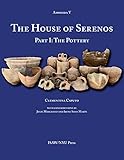The House of Serenos, Part I : The Pottery (Amheida V) / Clementina Caputo.
Material type: TextSeries: ISAW Monographs ; 10Publisher: New York, NY : New York University Press, [2020]Copyright date: 2020Description: 1 online resource : 261 color illustrations, 19 tablesContent type:
TextSeries: ISAW Monographs ; 10Publisher: New York, NY : New York University Press, [2020]Copyright date: 2020Description: 1 online resource : 261 color illustrations, 19 tablesContent type: - 9781479804658
- 9781479804696
- 932/.2 23
- DT73.D33 C37 2020
- online - DeGruyter
| Item type | Current library | Call number | URL | Status | Notes | Barcode | |
|---|---|---|---|---|---|---|---|
 eBook
eBook
|
Biblioteca "Angelicum" Pont. Univ. S.Tommaso d'Aquino Nuvola online | online - DeGruyter (Browse shelf(Opens below)) | Online access | Not for loan (Accesso limitato) | Accesso per gli utenti autorizzati / Access for authorized users | (dgr)9781479804696 |
Frontmatter -- Contents -- Acknowledgements -- List of Figures, Tables, and Plates -- Foreword -- Introduction -- Chapter 1: Methodological Approaches -- Chapter 2: Functional Classification and Shapes in Area 2.1: Typo-Chronological Study -- Chapter 3: Pottery Catalogue of Area 2.1 (above and below B1, S2, S3) -- Chapter 4: Pottery from Occupation Levels (B1, S2, S3) -- Chapter 5: Pottery Before B1: Dumped Material in Area 2.1 -- Chapter 6: The Private Dump of Serenos’ House -- Conclusions -- Concordance of Inventory Numbers and Catalogue Numbers -- Bibliography -- Figures
restricted access online access with authorization star
http://purl.org/coar/access_right/c_16ec
A comprehensive archaeological study of the ceramic finds from a house in AmheidaThe House of Serenos: Part I: The Pottery (Amheida V) is a comprehensive full-color catalog and analysis of the ceramic finds from the late antique house of a local notable and adjacent streets in Amheida. It is the fifth book in the Amheida series.Amheida is located in the western part of the Dakhla oasis, 3.5 km south of the medieval town of El-Qasr. Known in Hellenistic and Roman times as Trimithis, Amheida became a polis by 304 CE and was a major administrative center of the western part of the oasis for the whole of the fourth century. The home’s owner was one Serenos, a member of the municipal elite and a Trimithis city councillor, as we know from documents found in the house. His house is particularly well preserved with respect to floor plan, relationship to the contemporary urban topography, and decoration, including domestic display spaces plastered and painted with subjects drawn from Greek mythology and scenes depicting the family that owned the house. The archaeology from the site also reveals the ways in which the urban space changed over time, as Serenos’s house was built over and expanded into some previously public spaces. The house was probably abandoned around or soon after 370 CE. The pottery analyzed in this volume helps to refine the relationship of the archaeological layers belonging to the élite house and the layers below it; it also sheds light on the domestic and economic life of the household and region, from cooking and dining to the management of a complex agricultural economy in which ceramics were the most common form of container for basic commodities. The book will be of interest to specialists interested in ceramology, Roman Egypt, and the material culture, social history, and economy of late antiquity.
Mode of access: Internet via World Wide Web.
In English.
Description based on online resource; title from PDF title page (publisher's Web site, viewed 20. Nov 2024)


